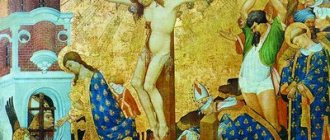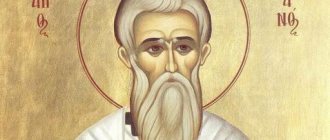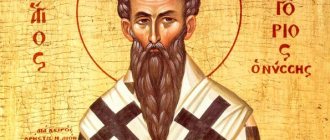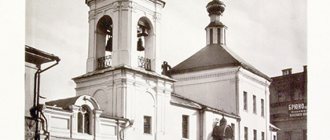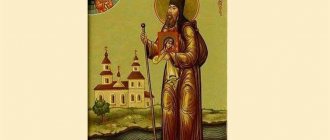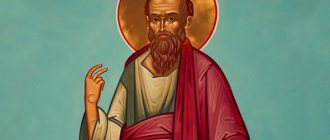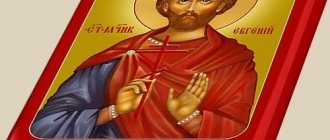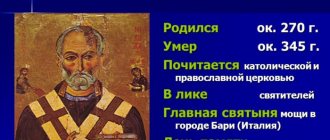| St. Cyril of Jerusalem |
Cyril I
(315 - 386), Bishop of Jerusalem, Saint Commemorated March 18
Born in Jerusalem in 315 and raised in strict Christian piety. Having reached adulthood, he became a monk, and in 346 he became a presbyter. In 350 or 351 after the death of Archbishop Maximus, he became his successor at the See of Jerusalem.
Living during the greatest unrest in the church from the Arians, he was overthrown by them three times from the episcopal see.
The heretic Akakios of Caesarea, deposed by the Sardician Council, decided to expel St. Cyril, using the assistance of the emperor (it is interesting that it was Akakios of Caesarea who at one time installed St. Cyril as bishop). When a severe famine occurred in Jerusalem, Saint Cyril spent all his property on works of mercy. Since the famine did not stop, the saint began to sell church items, using the proceeds to buy wheat for the hungry. The saint's enemies spread a rumor that they had seen a woman in the city dancing in sacred vestments. Taking advantage of this rumor, the heretics forcibly expelled the saint.
The saint found shelter with Bishop Silvanus in Tarsus. After this, the Local Council met in Seleucia, to which about 150 bishops arrived. Among them was St. Cyril, whom Metropolitan Akakios of Caesarea wanted to exclude from the meetings, but the Council did not agree. Then Akaki left the Council and before the emperor and the Arian Patriarch Eudoxius slandered both the Council and St. Cyril. The emperor subjected the saint to imprisonment.
When Emperor Julian the Apostate (361 - 363) reigned, he, supposedly out of piety, abolished all the decrees of Constantius directed against the Orthodox. Saint Cyril returned to his flock. After some time, when Julian established himself on the throne, he openly renounced Christ. He allowed the Jews to restore the Jerusalem Temple destroyed by the Romans and even allocated them part of the funds from state taxes for the construction. Saint Cyril predicted that the words of the Savior about the destruction of the very stones of the temple (Luke 21:6) would undoubtedly come true, and Julian’s blasphemous plan would fail. One night there was such a strong earthquake that even the surviving foundations of the ancient Solomon's temple moved, and the newly erected ones fell and crumbled to dust. When the Jews finally began construction again, fire fell from the sky and destroyed the working tools. Great horror gripped everyone. The next night, the sign of the cross appeared on the clothes of the Jews, which they could not destroy in any way.
After this heavenly confirmation of the prediction of Saint Cyril, he was expelled again, and Saint Cyriacus took the see of Jerusalem. But soon Saint Cyriacus suffered a martyr’s death (+ 363, commemorated October 28).
After the death of Emperor Julian, Saint Cyril returned to the see, but during the reign of Emperor Valens (364 - 378) he was sent into exile for the third time. Only under the holy and blessed Tsar Theodosius the Great (379 - 395) did he finally return to his archpastoral activities. In 381, Saint Cyril participated in the Second Ecumenical Council, which condemned the heresy of Macedonius and approved the Nicene-Constantinopolitan symbol.
Saint Cyril died in 386.
Life of Saint Cyril of Jerusalem
Christianity survived and spread throughout the world thanks to people who were not afraid to go against the pagan laws existing in their country. In the 4th century, Cyril lived in Jerusalem, a man who firmly believed in Christ and devoted his entire life to serving the Savior. Nothing is known about his childhood.
Cyril was born (presumably) in 315 in Jerusalem or its environs. Having accepted Christianity, he decided to preach the teachings of Christ to people. In 335 he was ordained deacon by Archbishop Macarius of Jerusalem. He served in this rank for ten years. In 345 another archbishop, Maximus, was awarded the presbyteral degree. As a presbyter, Cyril read sermons in the Jerusalem temple. His duties included preparing pagans for baptism.
In 351 Cyril was elected Archbishop of Jerusalem. The former head of the Jerusalem church, Maximus, may have been removed from his position. Although there is a version that he died. At the moment when Cyril became Archbishop of Jerusalem, a huge luminous cross appeared in the sky above the city. Such a sign was sent by God and meant that a truly pious Christian had become the head of the church in Jerusalem. Residents of the city gathered in the temple to listen to the sermon of their spiritual father. Many pagans, believing in the power of the Lord, converted to Christianity in those days.
The people of Jerusalem loved and respected their new shepherd. However, Cyril had enemies among the clergy. For many years he was in conflict with Akaki, Metropolitan of Palestine. The conflict was caused by differences in the interpretation of God's word. The Metropolitan of Palestine was an Arian; he did not like Cyril’s dogmatic views. Akaki was looking for a reason to remove the shepherd of Jerusalem, respected by the people, from his post. Soon the Metropolitan of Palestine had an opportunity to get even with the enemy.
A terrible disaster happened in Jerusalem - a terrible famine. People were starving and came to the temple, praying to God for salvation. The archbishop distributed all the church money to the hungry. True, this turned out to be not enough. A huge number of people could not buy bread and died of hunger. Then the archbishop ordered to sell church property (expensive vessels, curtains), and distribute the proceeds to the poor.
Akaki learned about affairs in the Jerusalem diocese. However, instead of praising Cyril, the Metropolitan of Palestine accused him of embezzling church money and selling off church property. Akaki convened a Council, at which the bishops decided to remove Cyril from the post of Archbishop of Jerusalem.
In 357, the former head of the church of Jerusalem left his hometown and its loyal inhabitants. In Tarsus he was sheltered by Bishop Silouan. Akakios, having learned where his longtime enemy was staying, sent a message to the local clergyman asking him not to host the removed Archbishop of Jerusalem. However, Silouan did not listen to him.
In 359, at the Council of Seleucia, the former Archbishop of Jerusalem was reinstated. However, Akaki in 360 gathered a new meeting of the clergy in Constantinople and again removed his enemy from governing the flock.
Cyril returned to Jerusalem only during the reign of Julian. True, the new ruler was a pagan, so he did not particularly favor Christians. Julian even ordered the construction of a Jewish temple in Jerusalem. All the Jews of the city joyfully received this news. Only the archbishop was not happy about the decree. He predicted that there would be an earthquake that would leave no stone unturned in the Jewish temple. Soon the prophecy of the Christian shepherd came true.
After Julian, the Arian Valens ascended the throne. In 367 the new emperor expelled the old archbishop from Jerusalem. More than ten years have passed. Theodosius I became the new ruler of the lands. In 379, the Archbishop of Jerusalem returned to his see. In 381, Cyril attended the Second Ecumenical Council in Constantinople, thanks to which the Nicene-Constantinople Creed was adopted. The following year, at a meeting of the clergy, the Archbishop of Jerusalem was praised for his services to the church. In 386 (387) the clergyman Cyril died. He died on March 18, so a holiday was established in his honor on this day.
Saint Cyril, Archbishop of Jerusalem
- Preface teaching, or preface.
The preparatory word explains to those preparing for baptism the superiority of their new state and the responsibilities associated with it and indicates how they should spend the time before baptism, preparing for a worthy acceptance of it.
The first catechetical teaching introduces those approaching baptism.
He calls for baptism, indicates its necessity for a person and its beneficial results, and exhorts him to adequately prepare himself for accepting it, since God gives abundant grace not indiscriminately, not without attention to the spiritual mood of a person.
The second lecture is about repentance, forgiveness of sins and about the enemy.
The need for repentance of sins for those preparing for baptism and confession of them for the entire past life is revealed. For this purpose, St. Cyril depicts the destruction of sin for man, its origin from man’s abuse of free will and the temptation of the devil, and with examples from Holy Scripture he proves that the means of healing from sins lies in repentance on the part of man and in the infinite goodness of God.
The third catechetical teaching is about baptism.
Baptism, which is spoken of in the third word, in it God forgives the sins of all sinners who repent of them; the speaker glorifies the greatness of the sacrament, proves its necessity for salvation, indicates its visible side - the water washing the body, and the invisible - the grace of the Holy Spirit, cleansing the soul from sinful filth, the miraculous consequences of baptism: remission of sins, even the most serious ones, union with Christ, assimilation [To him], etc.
The fourth lecture is about the ten dogmas.
Concisely sets out the essence of the teaching about God, about Jesus Christ, His incarnation, death on the cross, burial and descent into hell, about His resurrection, ascension into heaven, sitting at the right hand of the Father and the Second Coming, about the Holy Spirit, about the nature of man, his soul and body , about the general resurrection and the last Judgment.
The fifth catechumen teaching is about faith.
From the V word begins the explanation of the symbol with an explanation of the word “believe”, and St. Kirill proves the power of faith, glorifies its dignity, necessity, saving actions and distinguishes two types of faith: faith as a person’s consent to assimilate the taught truth and faith as a gracious, miraculous power bestowed from God to a truly faithful Christian. Convincing us to accept by faith only the teaching of the Catholic Church, which he now communicates, St. Kirill concludes by giving the text of the Jerusalem symbol to learn by heart, with a warning not to reveal it to anyone other than Christians and not to write it down.
The following four vowel words explain the first member of the symbol:
The sixth catechumen teaching is about the sovereignty of God.
We are talking about the unity of God - against the pagans and some heretics, mainly the Manichaeans, and their teaching, origin and subsequent history are outlined.
Sermon seventh
The doctrine of God the Father is explained, that He is in the proper and true sense the Father of His Son Jesus Christ due to the eternal and most perfect birth, and that He is called the Father of all people in a completely different sense.
Catechetical Sermon Eighth
VIII Catechetical Word, explaining the word “Almighty,” refutes the pagans, Jews and those heretics who recognized two principles in the world and considered all wealth to be the property of the devil, and reveals the doctrine of Divine Providence, power and dominion, extending to everything in the world..
Catechetical Sermon Ninth
The doctrine of God as the Creator and Organizer of the entire visible and invisible world is set forth in the IX word; the idea that the world is fully worthy of being a product of Divine wisdom is proven by a concise description of the world and its parts.
Next the cataclysmic words of St. Kirill sets out the second member of the symbol:
Tenth Catechetical Teaching
He proves the need to believe in the Son of God, indicates the reason why He is called the One, and brings from the Old Testament evidence of His existence before the incarnation and of His eternal, true, inherent dominion over everything in the universe. The Lord's two names, "Jesus" and "Christ," are then explained, and His two offices as Savior and eternal High Priest are depicted.
Catechetical Sermon Eleventh
Dedicated to proving that Jesus Christ is the Only Begotten Son of God, the Son by nature, reveals in detail the incomprehensibility of the birth of the Son, shows that the Son is true God, so abiding in the Father and One with Him in divinity, kingdom, will, actions, which is not merges with the Father, and is not alien to Him as a creature, but is most perfectly similar to Him in everything and different from creation; finally, it affirms the eternity of the Son and His birth and teaches that the Son is inseparable from the Father, the Creator and King of everything visible and invisible and of the ages themselves..
The following four cataclysmic words speak of the incarnation of Jesus Christ:
Catechetical Sermon Twelfth
The truth of the incarnation of Jesus Christ is defended against the errors of Jews and heretics, the reasons for the incarnation are stated and its circumstances predicted by the prophets, the place, time and other details of the birth are depicted, especially the fact of the birth from the Virgin.
Catechetical Teaching Thirteenth
In the thirteenth word, the preacher moves on to the suffering, death and burial of Jesus Christ, shows the truth and necessity of these events, speaks in detail about Christ's satisfaction with the righteousness of God for the sin of all people and describes all the circumstances of the Savior's death on the cross, constantly pointing to the exact fulfillment of Old Testament prophecies in them.
Citation fourteenth
Word XIV offers detailed teaching about the resurrection of the Lord, His ascension and His sitting at the right hand of the Father.
Catechetical Sermon fifteenth
Talks about the second coming, the signs preceding and accompanying it, describes the world judgment and affirms the eternity of the Kingdom of Christ.
Track. announcements about the Holy Spirit, His deity and grace-filled activity in the world:
Catechetical teaching sixteenth.
Catechetical Sermon Seventeenth.
About the resurrection of the flesh, about the Church:
Catechetical Sermon Eighteenth
In the XVIII word the resurrection of the flesh is defended against the objections of pagans, Samaritans and heretics and the properties of resurrected bodies are described. Then we talk about the Catholic Church, its foundation, its signs, its name and dignity, and, finally, about eternal life, which is offered in the Church to all who know the truth and live righteously, and about the many different ways to inherit this life, granted to people in the Church from God by His infinite goodness. In conclusion, St. Cyril points to the mystical instructions that are coming in Easter week and calls on his listeners to rejoice in the happiness that they will receive in baptism.
Meaning and veneration in Orthodoxy
Cyril of Jerusalem adhered to the traditional interpretation of the word of God. Throughout his life, he tried to convey the truth of Christ to people darkened by various errors. He wrote several works that are still used today as church teaching. In his writings, the Archbishop of Jerusalem clearly and accurately outlined the main tenets of the Christian faith. Thanks to Cyril, believers received the teaching about the Trinity, the sacraments of baptism, confirmation, and the Eucharist.
For his services to the church, the Archbishop of Jerusalem was canonized as a saint. The saint's memorial day falls on March 18 (31). The liturgy in honor of His Holiness Father Cyril is held by both the Orthodox and Catholic churches.
Literature
- N. I. Barsov, “Representatives of the dogmatic-polemical type of preaching in the 4th century.” (Kharkov, 1886);
- Touttée (at his publication of the works of Cyril of Jerusalem), “De vita et rebus gestis, de scriptis et de doctrina Cyrilli”;
- Tillemont, “Mémoires...” (vol. VIII);
- Oudin, “De script. eccesiast." (Vol. I);
- Ceiller, “Histoire générale des auteurs” (Vol. VI, after the 1860 edition);
- monographs:
- Plitt, "De Surilli orationibus, quae exstant" (Heidelberg, 1855);
- Marquardt, "S. Cyrillus, baptismi, chrismatis, eucharistiae interpres" (Leipzig, 1882);
- Archimandrite Porfiry, “Cyril of Jerusalem,” in “Additions to the works of St. fathers" (in Russian translation, 1855).
Iconography
The ancient images of the saint that have survived to this day date back to the 14th century. On the icons the saint was depicted in full growth or waist-length, but always dressed in a long robe with crosses. Cyril was depicted as a middle-aged man with dark (gray) hair, a small beard and a bare head. On some icons he is depicted wearing a pointed cap. In his left hand the saint holds the Gospel or a scroll, and with his right hand he blesses the believers. There are icons depicting the saint in many churches. If desired, the most holy image can be purchased at the church shop.
Orthodox texts
Saint Cyril is considered a man who opened the eyes of millions of believers to the basic tenets of Christianity. The saint is glorified for his teaching, which contains the words of true faith.
Kontakion
Believers glorify St. Cyril because he taught us to venerate and explained the meaning of the Trinity. The words of the wise teacher of the church enlightened the minds of a huge number of people.
Kontakion to Saint Cyril, Archbishop of Jerusalem, tone 4
With your tongue, wise one, / You enlightened your people with divine inspiration / the one Trinity of honor, / an indivisible nature, dividing the same Persons. / Moreover, rejoicing, your all-holy memory is ancestral We recognize those who offer you a prayer book to God.
Translation: Your word, O wise one, enlightened people with Divine inspiration, teaching them to honor the one Trinity, indivisible by Nature and divided by Persons. Therefore, rejoicing, we celebrate your all-holy memory, presenting you as a prayer book to God.
Canon
The canon, consisting of 9 songs, is pronounced in honor of the Mother of God and in honor of the great enlightener Kirill. Believers pray to the Immaculate Virgin to save souls from destruction and bestow grace.
Canon to Saint Cyril, Archbishop of Jerusalem
Song 1
Irmos: Tristates strong, Be born of the Virgin, dispassion in the depths, flood the tripartite soul, I pray that You, as in the tympanum, in the mortification of the body will sing a victorious song.
Having adorned the soul with the form of virtues, you completed the grace of this Holy Spirit, from where you vomited the abyss of wisdom, drying up the abyss of heresies, Cyril.
Having surpassed the mind of things you have done, you have shown yourself to be an accomplice of immaterial servants, and with the fire of your words you have consumed the whole thing of heresies, Cyril, the never-ending luminary of the Church.
Your word, with the sweet-breathing stench of the fury of the namesake, the wise one, drove away all the heresies intolerable feces, and created you far away, like the truest shepherd, like the fragrance of Christ ex.
Theotokos: From the times of passions, thoughts of anxiety, from the arrows of the evil one, from every adversary, save, O Pure Mother of God, the souls of those who sing of Your untold Nativity, O All-Immaculate One.
Song 3
Irmos: Because the Church has given birth to barren children, and many of the weak children of the congregation, let us cry to our wonderful God: Holy art thou, O Lord.
Shining with the lordship of spiritual wisdom, trissian Deity of the Trinity, Father, you have clearly made clear to those who exist on earth, from which we will be delivered from the darkness of darkness.
The Tsevnitsa appeared to you of the All-Holy Spirit, God-wise, proclaiming the song of the appearance of Christ, Whom you preached in two natures, delighting our souls.
Your soul has appeared in the house of holiness, in which the Father, and the Son, and the Life-Giving Spirit naturally dwell, and to Him we sing: Holy art thou, Lord.
Theotokos: Lower than the mind of heaven, more than the mind of Thy Nativity can say, O Young Lady, the Mind of the First in the womb of the Word, Pure One, conceived Thou, all things made up of words.
Sedalen, voice 8
Having enriched yourself with the wisdom of the Word, you vomited up the rivers of the living creatures from the teachings, and you gave water to every pious thought, and you fell with the divine club the flock on the grass, nourished by the divine out of my mind. Moreover, as a great shepherd and teacher and a faithful intercessor, we praise you, Saint Cyril, calling: pray to Christ, the God of sins, to forgive taxes to those who honor your holy memory with love ́.
Theotokos: Like a virgin and one in wives, Ty, who without seed gave birth to God's flesh, we please all, giving birth to humanity: fire has taken up residence in Ty of the Divinity, and like the Child, the daughter of Zizhd the Lord and the Lord. Therefore, the angelic and human race, we worthily glorify Your most holy Nativity and, in accordance with the cry of Ty: pray to Christ God to grant forgiveness of sins to those who worship in faith Your most holy Nativity .
Theotokos: The Lamb, and the Shepherd, and the Deliverer The Lamb beholds on the Cross, exclaiming, weeping, and, weeping bitterly, crying: the world rejoices, accept deliverance through You, my womb It burns, behold Your crucifixion, even as you endure mercy for mercy. Long-suffering Lord, abyss of mercy and inexhaustible source, be merciful and grant forgiveness of sins through faith to those who sing Your Divine Passion.
Song 4
Irmos: The heavens are covered with Thy virtue, and the earth is filled with Thy glory, O Christ. Moreover, we truly cry: Glory to Your power, Lord.
I stream the finest wisdom, sir, having accepted your heart, I will vomit the teachings into the abyss, plunging the minds of the ungodly.
You preached one fortress, one being, one will of the Trinitarian Divinity and polytheism, Cyril, the stream dried up the charms.
The clever and most insane Manentov, for he is intelligent and knowledgeable of God, blessed, having burned the brilliance of your words, he has clearly convicted you.
Theotokos: For having given birth to all creatures, the Pure One, you conceived the Creator of creation, and having given birth to nature, our nature is renewed.
Song 5
Irmos: You, Lord, my Light, you came into the world, Holy Light, turning those who sing Your praises from darkness of ignorance to faith.
With an honest rod, O saint, thy wisdom hast fallen on the water of Orthodox service to thy flock, O blessed one.
Your word is illuminated with Divine light, O Cyril! You destroyed the darkness of foolishness in the enlightened people in Jerusalem.
Theotokos: The Most Pure Night of passions and evil denigration covers my soul, giving birth to the Light-Giver, illuminate me, I pray.
Song 6
Irmos: The prophet Jonah cried out, prefiguring the three-day burial, praying in the whale: deliver me from aphids, O Jesus, King of hosts.
You are a river, like you came from another Eden, filled with the life-giving waters of the Spirit, and water the reins of the church, the saint.
The verb of your rays is that from the storm of the sea wickedness you save people, most sanctified, to the quiet haven of Orthodoxy calling them.
Theotokos: You have infuriated the earthed nature, All-immaculate, human and decayed, you have made new things, for this sake, O Youth, with all our silent voices we glorify You.
Kontakion, voice 4
With your tongue, wisdom, and divine inspiration, you enlightened your people with one Trinity of honor, inseparable by Nature, but divided by Persons. At the same time, rejoicing, we celebrate your all-holy memory, who also offer you a prayer book to God.
Song 7
Irmos: Three young men in Babylon, turning the command of the tormentor into violence, in the midst of the flames crying out: Blessed are you, O Lord, God our father.
Having fire in your mind, Father, the fear of God, you burned the sweets to ashes, chanting: Blessed are you, O Lord, God our father.
Having extinguished the flame with tears of passion, blessed one, you have preserved the light of your unquenchable soul, crying out: Blessed are you, O Lord, God our father.
Having a living stream with the flow of the Spirit, into the souls, God-wise, you have poured out, Father, rivers of teachings, the Church, watering, piously venerating.
Theotokos: The Holy One sanctifies all of You, taking flesh from Your flesh for Himself, O Theotokos, in the saints the living Lord, our God.
Song 8
Irmos: Omnipotent Redeemer of all, in the midst of the pious flame, He descended, watered you and taught you to sing: all you do, bless, sing to the Lord.
The slumber of negligence, blessed one, having abandoned the spiritual things, you have now fallen asleep like a righteous, decent one, and you have passed on to the day of the never-evening Light.
With the lightning of your words you struck down the boastful heresy, everlasting memory, and you enlightened the faithful to the one honor of the Trinity with inscriptions, in the Unity of the existing Nature.
Having sanctified yourself with your wives, you were dead for your sake, you sacrificed bloodlessly, like a Divine Hierarch, like a servant of the unspeakable mysteries, Kirill.
Theotokos: Having been delivered from the oath of the mother of God by You, O Pure Mother of God, Blessed Lady, we bless, O Most Glorified Virgin, Thy Most Holy Nativity, All-Pure One.
Song 9
Irmos: Eve, through the illness of disobeying the oath, instilled an oath, but You, Virgin Mother of God, through the vegetation of womb-bearing, the blessing of the world has blossomed. Thus we magnify you all.
Desiring to see the ineffable glory of Christ, the saint, you tried to mortify the soul-destroying passions and create greater and better wisdom for your heart. Moreover, we please you with faith.
Set a multi-bright star, Christ the Sun, on the church heights, Cyril, illuminating the hearts of those who faithfully fulfill your luminous memory, Reverend, with the rays of the sacred teachings.
Your interlocutor and co-celebrant was an angel, as if you were incorporeal, Father, having lived on earth, you appeared to be a venerable participant and an equal saint; Rejoicing with him, remember us.
The Mother of God: the well -defering God's virtues, the Most Holy Theotokos, the sourte show, the role, fruitfully, even from the Neckosyodov, I was growing up all the fulfilling maneuvers, but you sing, all -venerable.
Creative heritage
The main work of the saint is considered to be the work “Catechetical Teachings”. This work is not a theological treatise, but a series of instructive conversations by Cyril. The sermons were delivered in the temple by the clergyman himself at the beginning of his bishopric. This work contains 1 preliminary and 18 catechetical teachings. The work was presumably written in 350-351. In the work, the author talks about the topic of baptism, the importance of repentance and confession of sins, and true worship of God.
The continuation of the “Catechetical Teachings” is the work “Secret Teachings.” Several more texts have survived to this day, the authorship of which is attributed to the saint. For example, “Message to Emperor Constantius”, “Sermon on the Gospel reading about the paralytic”. These works are a rich source of historical knowledge for Christians.
The “Message to Emperor Constantius” dates back to the year 351, when a huge luminous cross appeared in the sky over Jerusalem.
World. Human. Word.
In the middle of the 4th century, the heresy of the Alexandrian priest Arius gained strength in the Christian world for some time. This preacher denied the unity of the Son of God and God the Father, called Jesus Christ a creation and did not recognize in him a Divinity equal to the Father. At the First Ecumenical Council in 325 in the city of Nicaea, Arianism was adopted. Arius himself was excommunicated from the Church. But among those in power, and even among bishops and priests, there were still many of his secret and overt followers.
Saint Cyril, the future Archbishop of Jerusalem, was born in Jerusalem in 315. He was brought up in the apostolic rules of Christian faith and piety. Already at the age of 35, Cyril was elected Bishop of Jerusalem. At that time, the Jerusalem diocese was subordinate to the Church of Caesarea. And it so happened that Saint Cyril was ordained bishop of Jerusalem by none other than Metropolitan Akakios of Caesarea. Akaki openly professed the Arian heresy. He said to Saint Cyril: “Behold, I place great trust in you by consecrating you as archbishop. I hope you will become my faithful companion." Saint Cyril did not answer, and soon Akaki realized that he had miscalculated. Throughout his life, despite the suffering he endured, Saint Cyril fought against the Arian heresy and defended the purity of the apostolic doctrine. And he did it fearlessly, regardless of the ranks and titles of the heretics.
The persecution of Archbishop Kirill began a year after he took the Jerusalem see. Then, on the day of the celebration of the Descent of the Holy Spirit on the Apostles, an extraordinary sign occurred, documented by historians and astronomers of that time. At about three o'clock in the afternoon, a dazzling outline of a cross appeared in the sky over Jerusalem. Saint Cyril wrote about this to Emperor Constantius, who oppressed the Orthodox and supported the Arians in every possible way. Archbishop Kirill convinced the ruler of the empire: “Oh, king! Abandon your heretical delusions and convert to true Orthodoxy!”
This was unheard of impudence on the part of the Archbishop of Jerusalem.
The heretic Metropolitan Akaki was on friendly terms with the heretic emperor. Even when the church council deposed Acacius and deprived him of the metropolitan title, Emperor Constantius canceled this council decision and restored Acacius in the administration of the Caesarea Church. After Saint Cyril refused to obey the illegal metropolitan, Akaki began to look for a reason to depose Cyril of Jerusalem himself. And such a reason was soon found.
A terrible famine broke out in Jerusalem. The people, falling off their feet, went to their beloved archpastor, Saint Cyril. They called out:
“Save us from starvation, man of God Kirill! Both we and our children are dying.” Saint Cyril gave away all his modest savings inherited from his parents, but this was clearly not enough. And then, filled with Christian compassion for people dying of hunger, the archbishop bought wheat with church money and distributed it among those in need. However, people continued to die from exhaustion. And Saint Cyril, filled with God’s boldness, took the extreme step. He began to exchange church treasures that had no liturgical use for bread. Akaki, having learned about this, rejoiced: “Bishop Kirill is selling sacred objects. From now on he will be dethroned from the archbishop’s throne and will be sent into exile.” Saint Cyril settled in the city of Tarsus, the homeland of the Apostle Paul, where he lived by alms.
After this, a local church council met, to which Saint Cyril of Jerusalem also considered it necessary to attend. The illegal Metropolitan Akaki demanded that he be removed from the council, but the majority of bishops did not agree with this. Honest bishops did not see any guilt in Saint Cyril. After all, he saved many people from starvation! Then Akaki went to Constantinople, to his friend Emperor Constantius and told him about the imaginary crimes of St. Cyril. The Emperor became furious: “Yes, this Kirill is a real villain! I order him to be thrown into prison for eternal imprisonment!”
Saint Cyril did not stay in the casemate for long: Emperor Constantius died, and the guards placed the wicked Julian the Apostate on the throne. In the first year of his reign, in order to gain popularity, he abolished all the anti-church decrees of Constantius. The slandered Orthodox bishops have emerged from captivity. Saint Cyril was returned to the See of Jerusalem. However, Julian soon loudly renounced Christ and began to restore paganism throughout the empire. Saint Cyril was again sent into exile, and Saint Cyriacus took the place of the Archbishop of Jerusalem. But just a few months later Saint Cyriacus was martyred by order of Julian the Apostate. And after this, the wicked emperor himself died in a campaign against the Persians. Saint Cyril again became the Archbishop of Jerusalem, and again - not for long: the new emperor Valens, being a follower of Arius, once again sent Saint Cyril into exile for his bold denunciations of heretics. Finally, the holy and blessed Emperor Theodosius the Great finally restored Saint Cyril to the See of Jerusalem, which he wisely ruled until his peaceful death in 386.
In 381, Archbishop Kirill took part in the Second Ecumenical Council in Constantinople. The Council condemned the heretics and approved the amended Creed. Saint Cyril also contributed to the council's decisions. He defined the Christian Church as “one, holy, catholic.”
In his sermons, Saint Cyril revealed the meaning of the sacrament of baptism as a likeness to the death and Resurrection of the Savior. He said to those who were about to be baptized:
“The great thing is the upcoming baptism. It is the liberation of captives, the remission of sins, the renewal of the soul, the holy indestructible seal, adoption to God. In baptism, everything that actually happened to the Savior also happens to us, but painlessly, without suffering. And in baptism we become partakers of the sufferings of Christ.”
